
Lizard is the common name used for all squamate reptiles other than snakes, encompassing over 7,000 species, ranging across all continents except Antarctica, as well as most oceanic island chains. The group is paraphyletic as some lizards are more closely related to snakes than they are to other lizards. Lizards range in size from chameleons and geckos a few centimeters long to the 3-meter-long Komodo dragon.

In zoology, a scale is a small rigid plate that grows out of an animal's skin to provide protection. In lepidopterans, scales are plates on the surface of the insect wing, and provide coloration. Scales are quite common and have evolved multiple times through convergent evolution, with varying structure and function.

Squamata is the largest order of reptiles, comprising lizards, snakes, and amphisbaenians, which are collectively known as squamates or scaled reptiles. With over 11,500 species, it is also the second-largest order of extant (living) vertebrates, after the perciform fish. Members of the order are distinguished by their skins, which bear horny scales or shields, and must periodically engage in molting. They also possess movable quadrate bones, making possible movement of the upper jaw relative to the neurocranium. This is particularly visible in snakes, which are able to open their mouths very wide to accommodate comparatively large prey. Squamates are the most variably sized living reptiles, ranging from the 16 mm (0.63 in) dwarf gecko to the 6.5 m (21 ft) reticulated python. The now-extinct mosasaurs reached lengths over 14 m (46 ft).
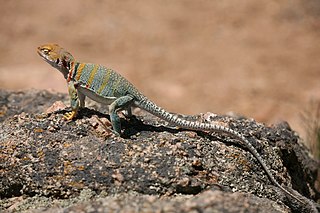
The Crotaphytidae, or collared lizards, are a family of desert-dwelling reptiles native to the Southwestern United States and northern Mexico. Alternatively they are recognized as a subfamily, Crotaphytinae, within the clade Pleurodonta. They are very fast-moving animals, with long limbs and tails; some species are capable of achieving bipedal running at top speed. This species is carnivorous, feeding mainly on insects and smaller lizards. The two genera contain 12 species.

Dibamidae or blind skinks is a family of lizards characterized by their elongated cylindrical body and an apparent lack of limbs. Female dibamids are entirely limbless and the males retain small flap-like hind limbs, which they use to grip their partner during mating. They have a rigidly fused skull, lack pterygoid teeth and external ears. Their eyes are greatly reduced, and covered with a scale.

Skinks are lizards belonging to the family Scincidae, a family in the infraorder Scincomorpha. With more than 1,500 described species across 100 different taxonomic genera, the family Scincidae is one of the most diverse families of lizards. Skinks are characterized by their smaller legs in comparison to typical lizards and are found in different habitats except arctic and subarctic regions.
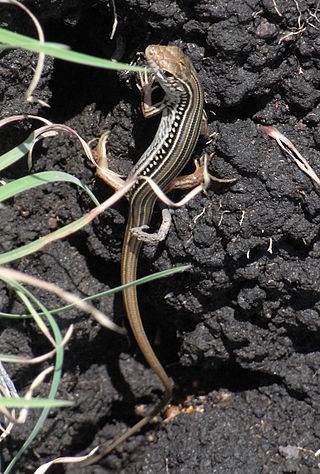
Ctenotus is a genus of skinks. It is endemic to Australia. The genus belongs to a clade in the Sphenomorphus group which contains such genera as Anomalopus and the close relatives Eulamprus and Gnypetoscincus.

Egernia is a genus of skinks that occurs in Australia. These skinks are ecologically diverse omnivores that inhabit a wide range of habitats. However, in the loose delimitation the genus is not monophyletic but an evolutionary grade, as has long been suspected due to its lack of characteristic apomorphies.

A scute or scutum is a bony external plate or scale overlaid with horn, as on the shell of a turtle, the skin of crocodilians, and the feet of birds. The term is also used to describe the anterior portion of the mesonotum in insects as well as some arachnids.
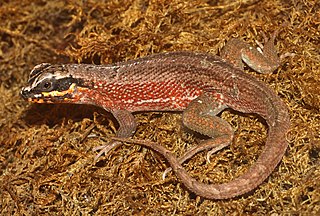
Iguania is an infraorder of squamate reptiles that includes iguanas, chameleons, agamids, and New World lizards like anoles and phrynosomatids. Using morphological features as a guide to evolutionary relationships, the Iguania are believed to form the sister group to the remainder of the Squamata, which comprise nearly 11,000 named species, roughly 2000 of which are iguanians. However, molecular information has placed Iguania well within the Squamata as sister taxa to the Anguimorpha and closely related to snakes. The order has been under debate and revisions after being classified by Charles Lewis Camp in 1923 due to difficulties finding adequate synapomorphic morphological characteristics. Most Iguanias are arboreal but there are several terrestrial groups. They usually have primitive fleshy, non-prehensile tongues, although the tongue is highly modified in chameleons. The group has a fossil record that extends back to the Early Jurassic. Today they are scattered occurring in Madagascar, the Fiji and Friendly Islands and Western Hemisphere.
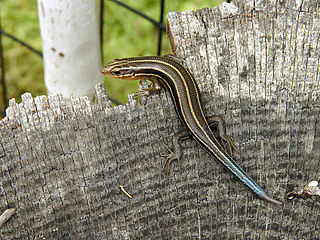
Autarchoglossa is a clade of squamates that includes skinks, anguimorphs, snakes, and relatives. Autarchoglossa is supported as a monophyletic grouping by morphological features in living and extinct lizards and snakes. Some phylogenetic analyses based on molecular features such as DNA sequences in living squamates do not support Autarchoglossa.

Osteoderms are bony deposits forming scales, plates, or other structures based in the dermis. Osteoderms are found in many groups of extant and extinct reptiles and amphibians, including lizards, crocodilians, frogs, temnospondyls, various groups of dinosaurs, phytosaurs, aetosaurs, placodonts, and hupehsuchians.

The Anguimorpha is a suborder of squamates. The group was named by Fürbringer in 1900 to include all autarchoglossans closer to Varanus and Anguis than Scincus. These lizards, along with iguanians and snakes, constitute the proposed "venom clade" Toxicofera of all venomous reptiles.

Scincinae is a subfamily of lizards. The subfamily contains 33 genera, and the genera contain a combined total of 284 species, commonly called skinks. The systematics is at times controversial. The group is probably paraphyletic. It is one of three subfamilies of the family Scincidae, the other two being Acontinae and Lygosominae.

Reptiles arose about 320 million years ago during the Carboniferous period. Reptiles, in the traditional sense of the term, are defined as animals that have scales or scutes, lay land-based hard-shelled eggs, and possess ectothermic metabolisms. So defined, the group is paraphyletic, excluding endothermic animals like birds that are descended from early traditionally-defined reptiles. A definition in accordance with phylogenetic nomenclature, which rejects paraphyletic groups, includes birds while excluding mammals and their synapsid ancestors. So defined, Reptilia is identical to Sauropsida.
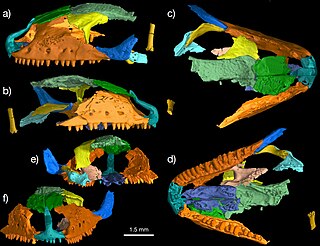
Paramacellodidae is an extinct family of lizards that first appeared in the Middle Jurassic around 170 million years ago (Ma) and became extinct at the end of the Cretaceous around 66 Ma. It was one of the earliest groups of lizards to have undergone an evolutionary radiation, with members found across the supercontinent Laurasia. The phylogenetic relationships and constituent species of Paramacellodidae are uncertain. Many studies regard them to be scincomorphs, a large group that includes skinks and their closest extinct relatives, and possibly also to Cordyoidea, a group that includes spinytail lizards and relatives. Like modern skinks, paramacelloidids had rectangular bony plates called osteoderms covering most of their bodies, including their backs, undersides, and tails. They also had short and robust limbs. Paramacellodids are distinguished from other lizards by the combination two traits in their dentition, the teeth are labiolingually expanded at their bases, and the tooth apices are lingually concave.

Acrodonta are a subclade of iguanian squamates consisting almost entirely of Old World taxa. Extant representation include the families Chamaeleonidae (chameleons) and Agamidae, with at least over 500 species described. A fossil genus, Gueragama, was found in Brazil, making it the only known American representative of the group.
Osteoderms are dermal bone structures that support the upper layer of skin and serve as protection against the elements in a large variety of extinct and extant organisms, especially reptiles. This structure is commonly called "dermal armor" and serves to protect the organism, while also helping with temperature regulation. Osteoderms represent hard tissue components of the integument, making them easy to identify in fossil examination. This dermal armor is found prominently in many lizards. Some early amphibians have this armor, but it is lost in modern species with the exception a ventral plate, called the gastralia.
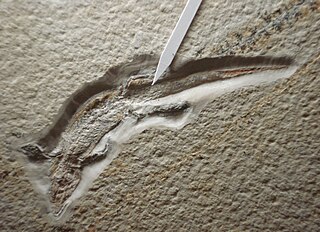
Ardeosauridae is an extinct family of lizards known from the Late Jurassic of Germany and North America and Early Cretaceous of Mongolia, with other potential species elsewhere from Europe and Asia over the same time period.
Globauridae is a family of extinct scincomorph lizards that first appeared in the Late Jurassic of England and persisting until the Late Cretaceous of Mongolia. The group is distinguished by having a diploglossopalatinar palate anatomy, lacking osteoderms, having conical two- or three-cusped teeth, and a unique postorbital-parietal contact. The type genus Globaura was originally classified within the now-polyphyletic group Lacertoidea, before being reclassified within its own family within Ardeosauroidea. However, Meyasaurus has also been found to be closer to Barbatteiidae.




















